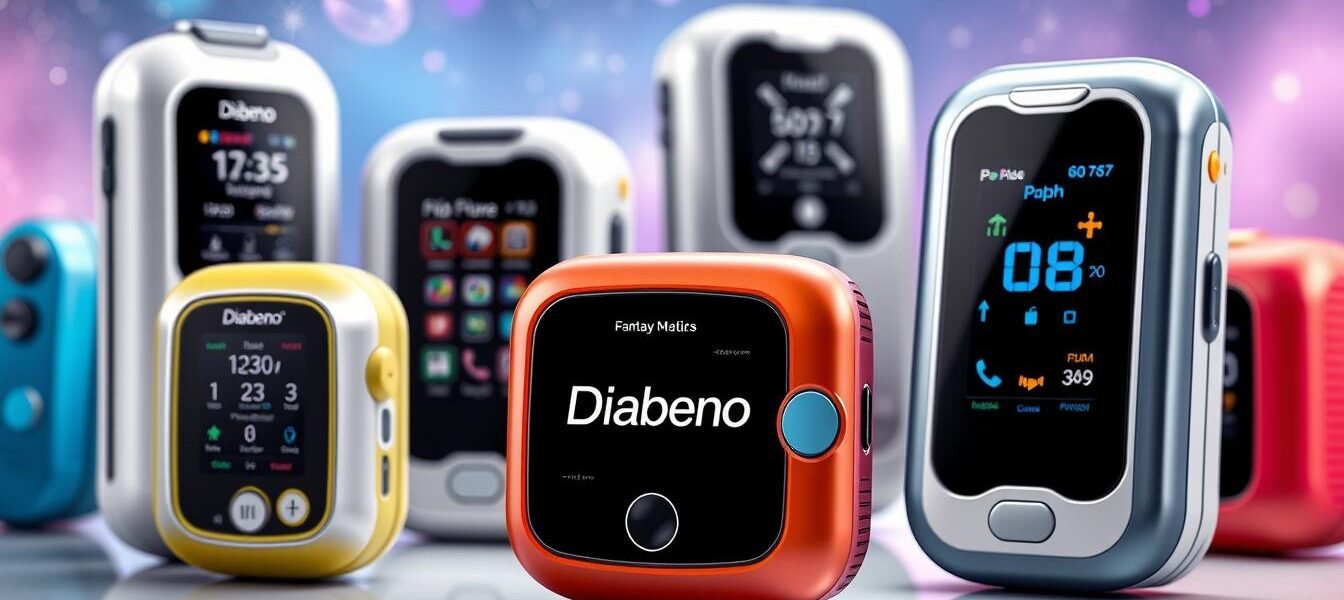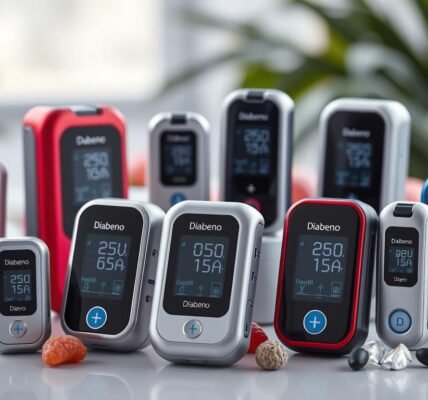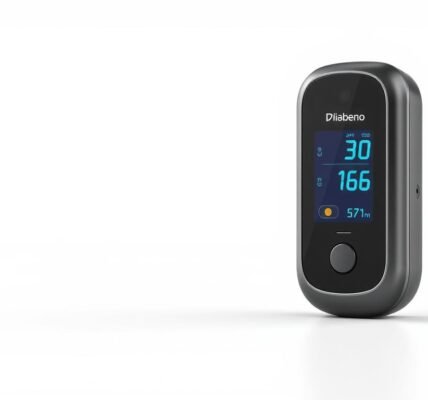William Ernest Henley once said, “I am the master of my fate, I am the captain of my soul.” This is especially true for teenagers with diabetes. The right insulin pump can change their lives and help them control their health. Thanks to new insulin pump technology for teens, they can live better and manage their blood sugar better.
The best insulin pumps for teenagers help keep blood sugar stable. They also offer flexibility and convenience. This makes them key tools in teenage diabetes care.
This article will look at the top insulin pumps for teenagers. We’ll focus on the features and benefits that are most important for youth diabetes management. You’ll learn about patch pumps that don’t have tubes and tethered systems that give insulin all the time. It’s important to know about these options, whether you’re looking for one for your child or someone you care about.
Discover how insulin pumps for teenagers can help them manage their diabetes with confidence and ease.
Key Takeaways
- Insulin pumps can significantly enhance diabetes management for teenagers.
- Patch pumps offer a tubeless design, improving comfort and ease of use.
- Tethered pumps provide continuous insulin delivery through a connected tube.
- Understanding pump features is essential for effective youth diabetes management.
- Consultation with healthcare providers is necessary to select the right pump.
Understanding Insulin Pumps
Insulin pumps are a big step forward in diabetes technology for teens. They give insulin all day long, making it easier for teens to manage their diabetes. Unlike shots, these pumps are small and connected to a thin tube under the skin. A study found that 63% of teens prefer these pumps over shots because they are easier to use1.
Switching to an insulin pump can make life easier and more flexible for teens. They can change how much insulin they get based on what they’re doing, like eating out or playing sports. This helps keep their blood sugar levels stable, which is shown by lower A1c levels in pump users2.
Insulin pumps also make it simple to manage the insulin you need all the time. You just need to change the tube every three days, which fits into most people’s schedules. Knowing how to use the pump well and counting carbs accurately are key to managing diabetes well1.
Importance of Insulin Pumps for Diabetes Management
Insulin pumps are key in managing diabetes with insulin pumps. They offer better insulin delivery than injections. They adjust to your blood sugar and lifestyle needs.
These pumps are flexible, changing insulin rates for exercise or food changes. This is great for active teens. They help keep blood sugar stable with basal and bolus delivery3.
Using them can lower the risk of low blood sugar. This makes them safer and more comfortable for users3.
These devices need regular care, like changing infusion sets every two to three days. This is easier than taking injections many times a day3. Most insurance covers insulin pumps, but having the right supplies is important to avoid extra costs4.
It’s also important to watch for infections at the catheter sites. This is to avoid serious problems like diabetic ketoacidosis5.
In the end, insulin pumps improve your life quality. They make managing insulin easier, allowing for a more active life. Using this technology can help you reach your health goals5.
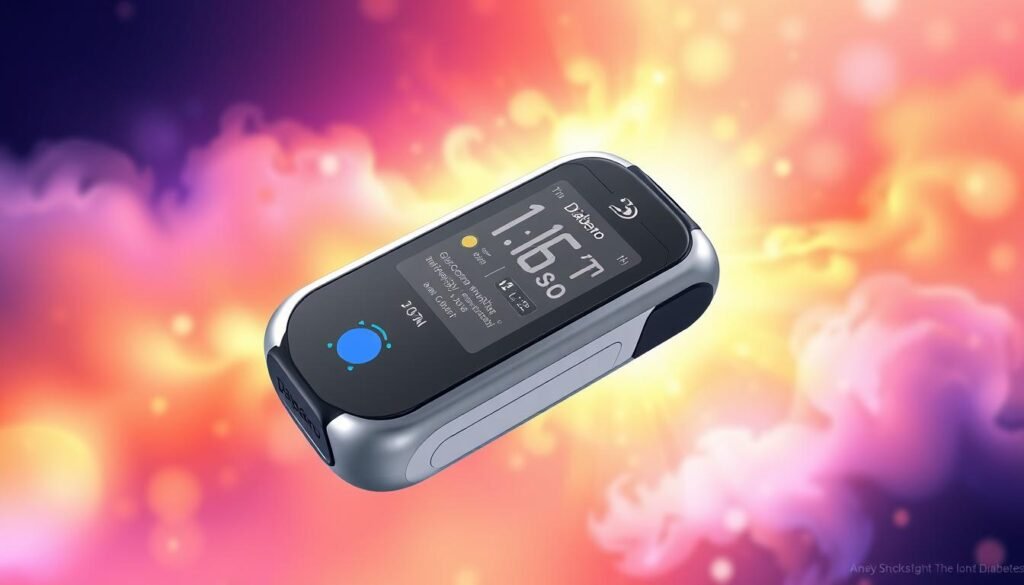
Types of Insulin Pumps Available
When looking at insulin pump options, you’ll find two main types: patch pumps and tethered pumps. Knowing the differences helps you pick the right one for you.
Patch Pumps
Patch pumps are small, stick-on devices that send insulin through your skin. They work without wires, offering easy, ongoing insulin delivery. The Omnipod® Insulin Management System, a top patch pump, gives up to 72 hours of insulin without the need for tubing6.
For teens, the Omnipod 5 Intro Kit 30-Day Trial is a great start. It lets users try out this tech before deciding. These pumps only need to be changed every two to three days6.
Tethered Pumps
Tethered pumps have a tube linking the pump to insulin outside your body. Brands like Tandem’s t:slim X2 and Medtronic’s MiniMed are popular choices. They offer precise insulin delivery and adjust based on glucose levels, improving diabetes care7. However, they require more upkeep, as pump sites need regular checks.
The t:slim X2 insulin pump works with NovoLog and Humalog U-100 insulin, suitable for those six years and older7. Its Control-IQ tech adjusts insulin delivery for better blood sugar control all day7.
| Type of Pump | Key Features | Maintenance Frequency | Typical Users |
|---|---|---|---|
| Patch Pumps | Tubeless, wireless, delivers insulin directly through the skin | Change every 2-3 days | Individuals seeking convenience and ease of use |
| Tethered Pumps | Uses tubing, can adjust insulin delivery in real time | Requires regular site monitoring | Individuals comfortable with technology, including teens |
Knowing about these types of insulin pumps helps you make better choices for managing your diabetes. Each type has its own benefits, fitting different needs and lifestyles.
How Do Insulin Pumps Work?
Insulin pumps are key for managing diabetes. They give insulin all day to keep blood sugar levels right. They work by sending insulin in two ways: basal and bolus. These methods help the pump act like the pancreas.
Basal and Bolus Delivery
Basal delivery gives insulin all day to keep blood sugar steady. It’s important for those who don’t eat often. Bolus delivery gives insulin with meals to handle blood sugar spikes after eating.
Insulin pumps can give small doses, as low as 0.025 units. This makes them fit each person’s needs well3. Kids with type 1 diabetes often use rapid-acting insulin in their pumps. This helps them quickly handle changes in blood sugar3.
Integrating Continuous Glucose Monitors
Using continuous glucose monitors (CGMs) with insulin pumps makes managing diabetes better. The pump can adjust insulin based on real-time glucose data. This reduces the chance of low blood sugar and makes insulin delivery more precise9.
The latest technology in insulin pumps helps manage glucose better. This can improve focus and reduce school disruptions for kids9. It also helps with better sleep at night9. Knowing the costs and support options is important to get the most from insulin pumps3
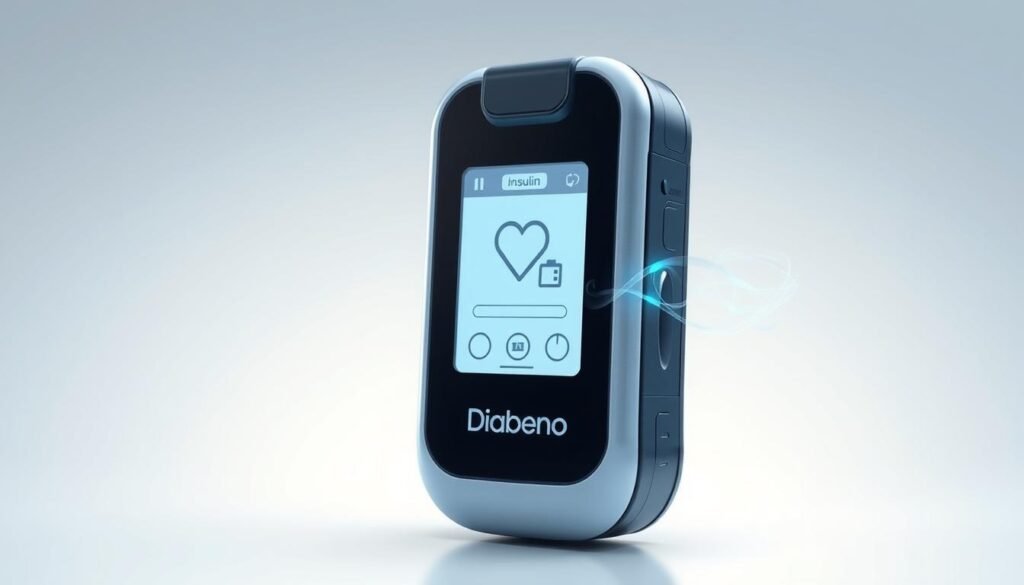
Benefits of Using Insulin Pumps for Teenagers
Insulin pumps can greatly improve the lives of teens with diabetes. They offer better blood sugar control and more freedom. This is especially important for teens who value flexibility and convenience.
Improved Blood Sugar Control
Insulin pumps help keep blood sugar levels stable. This reduces big swings and the chance of very low blood sugar5. People using pumps have fewer hypoglycemia problems than those with daily shots5.
They can set different insulin rates for different times. This is great for teens who need tight blood sugar control10. Users often see better hemoglobin A1c levels and diabetes management with pumps11.
Flexibility and Convenience
Insulin pumps offer a flexible insulin schedule, unlike daily shots. This fits well with the changing lives of teens5. They can easily take small doses anywhere, making it easier to join in activities.
This convenience boosts their quality of life11. Pumps also help with accurate carb counting and insulin dosing. This supports effective diabetes care for teens10.
Top Insulin Pumps for Teenagers in 2023
Choosing the right insulin pump is key for teens with diabetes. This year, several pumps are top picks for their cool features and easy use. These pumps are designed with teens in mind, making them the best for 2023.
Omnipod 5
The Omnipod 5 is a favorite because it’s tubeless. This means less hassle with tubing and more freedom. It can pump up to 30 units per hour and holds 200 units of insulin. It works with the Dexcom G6, giving teens real-time glucose data12.
It’s also very light, weighing just 26g. This makes it a great choice from many insulin pump brands13.
Tandem T-Slim X2
The Tandem T-Slim X2 is sleek and compact. It’s tethered to tubing but has cool tech. Its battery lasts up to 7 days, so you don’t need to replace it often.
It can pump up to 35 units per hour and holds 300 units of insulin. It’s also great for active teens12. Plus, it works with the Dexcom G6 for easy glucose monitoring12.
Medtronic MiniMed 770G
The Medtronic MiniMed 770G has a built-in glucose monitor. It’s designed to be comfy for teens, weighing 95.7g. It can pump up to 35 units per hour and holds 300 units of insulin.
It also works with the Guardian 4 sensor for accurate glucose checks. This makes it a top choice for teens12.
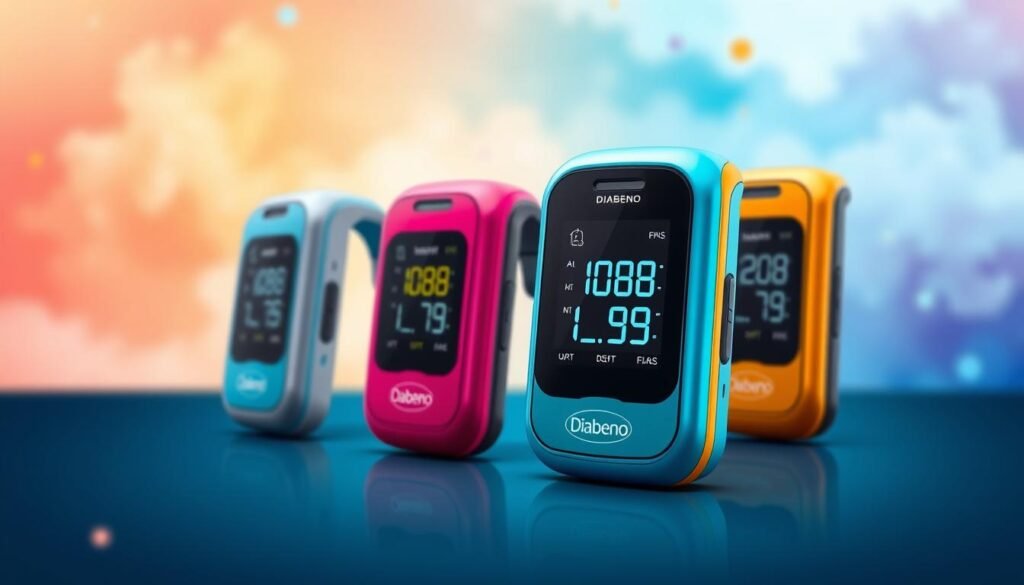
| Feature | Omnipod 5 | Tandem T-Slim X2 | Medtronic MiniMed 770G |
|---|---|---|---|
| Insulin Capacity | 200 units | 300 units | 300 units |
| Maximum Basal Rate | 30 units/hr | 35 units/hr | 35 units/hr |
| Weight | 26g | 112g | 95.7g |
| Battery Type | Not applicable | Rechargeable lithium | 1 AA battery |
| Compatibility | Dexcom G6 | Dexcom G6 | Guardian 4 |
Insulin Pumps for Teenagers: Features that Matter
Choosing the right insulin pump is key for teens with diabetes. Important features make a big difference in their daily lives. Look for pumps that are easy to use and comfortable.
User-Friendly Interfaces
User-friendly insulin pumps have simple interfaces. They make managing diabetes easier for teens. These interfaces are easy to navigate, so teens can adjust settings without needing to know a lot.
Having an easy-to-read display and simple functions helps teens stay involved in their care.
Battery Life and Durability
Battery life and durability are also crucial. Teens need pumps that last long, so they can use them all day. This is especially important during school or sports.
Durable pumps can handle the daily wear and tear. This means they are less likely to get damaged.
Customizable Settings
Customizable settings are vital for teens. They can adjust their insulin and meal settings to fit their lifestyle. This gives them control over their diabetes care.
Being able to customize can improve health and quality of life. It shows how important it is to tailor diabetes care to each person.
Knowing about these features helps you choose the right pump for your teen. The right pump can make a big difference in their diabetes management. It can help them feel more in control and independent.
Recent studies show big benefits from using insulin pumps well in teens. This highlights the importance of these features for success.
Learn more about managing diabetes with technologies like insulin pumps14
Choosing the Right Insulin Pump for Your Teen
Choosing the right insulin pump for your teen is important. It must fit their lifestyle and needs. Insulin pumps are better than injections or pens for controlling blood sugar15. They adjust insulin delivery based on individual needs15.
Insulin pumps are flexible, which is great for active teens. They can handle different meal times and activities15.
When looking for an affordable insulin pump for teenagers, consider costs. Insulin pumps can cost over $5,000, and insurance may not cover all costs15. Changing infusion sets and reservoirs is needed often, which can be time-consuming15.
It’s also important to know about possible complications. These can include infections or issues with the infusion site15.
Think about what your teen needs. Look for features that match their comfort and preferences. If your teen prefers using a pump, is active, or has frequent low blood sugar, a pump might be right4.
Insulin pump therapy is flexible. It allows some to switch between pumps and injections4.
Do your research on the best insulin pump choices. Talking to diabetes care teams can help. They can guide you based on your teen’s needs and your budget4.
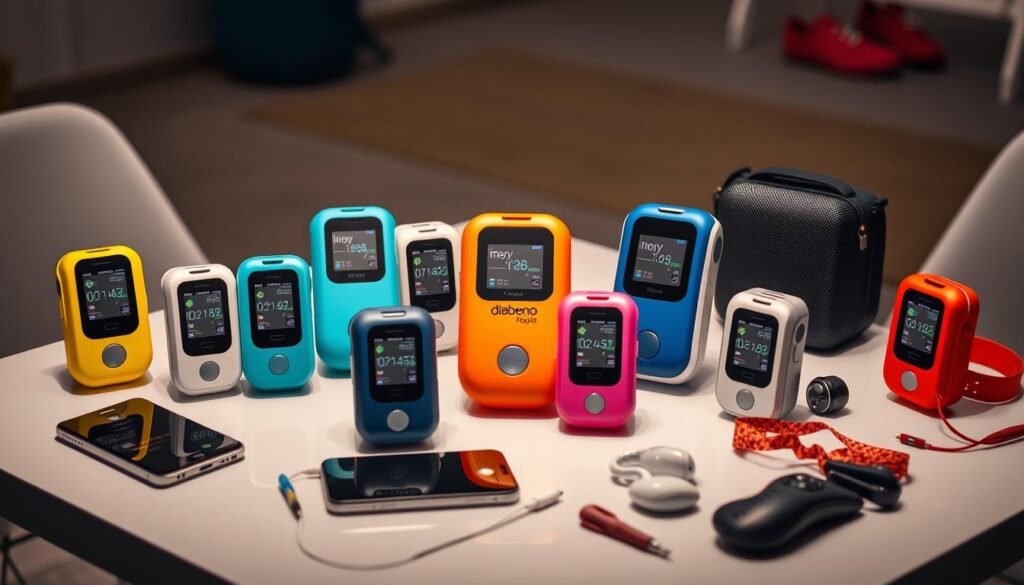
Insulin Pump Accessories for Teenagers
Personalizing insulin pumps can make a big difference for teenagers with diabetes. Teen-friendly accessories add function and let them show their style. The right ones make managing diabetes easier and boost confidence.
Carrying Cases and Pouches
Carrying cases and pouches keep insulin pumps safe and easy to reach. Brands like Grandma’s Hands and Groovy Patches make custom pouches for teens. These insulin pump accessories for teenagers are stylish and useful. They protect the pumps and let teens show off their style.
Skins and Customizations
Decorative skins are a big hit for insulin pump customization for adolescents. Companies like Pump Wear, Inc. and Pump*tastic have cool designs. These skins let teens show their personality while keeping their pumps working well. Products like IV3000 and Tegaderm also offer extra protection.
In short, using teen-friendly insulin pump accessories helps teens feel more in charge of their diabetes. Fun designs and useful features make managing diabetes a chance for self-expression1617.
Insulin Pump Therapy for Youth: A Comprehensive Look
Managing diabetes well is key for young people. Insulin pumps help a lot with this. They make sure insulin is delivered right, which is great for teenage diabetes management.
These pumps have been around for over 20 years. Before, kids had to take insulin shots twice a day. Now, pumps help keep their blood sugar levels safe all day18.
Long-Term Management and Care
Teens with insulin pumps use special monitors too. These devices check blood sugar every five minutes. This gives them real-time info to manage their diabetes better19.
Research shows that careful diabetes care can really help. It can lower blood sugar levels for good18. Parents help kids learn to manage their diabetes. This builds their confidence and independence.
It’s also important to deal with mental health issues like anxiety and depression. This helps them feel better overall19.
Support Systems for Teens
Having a strong support system is crucial for teens with diabetes. Family, friends, and doctors need to work together. They should create a caring environment.
Getting help from diabetes educators is also helpful. They can teach about new treatments and technologies. This makes managing diabetes easier and more positive19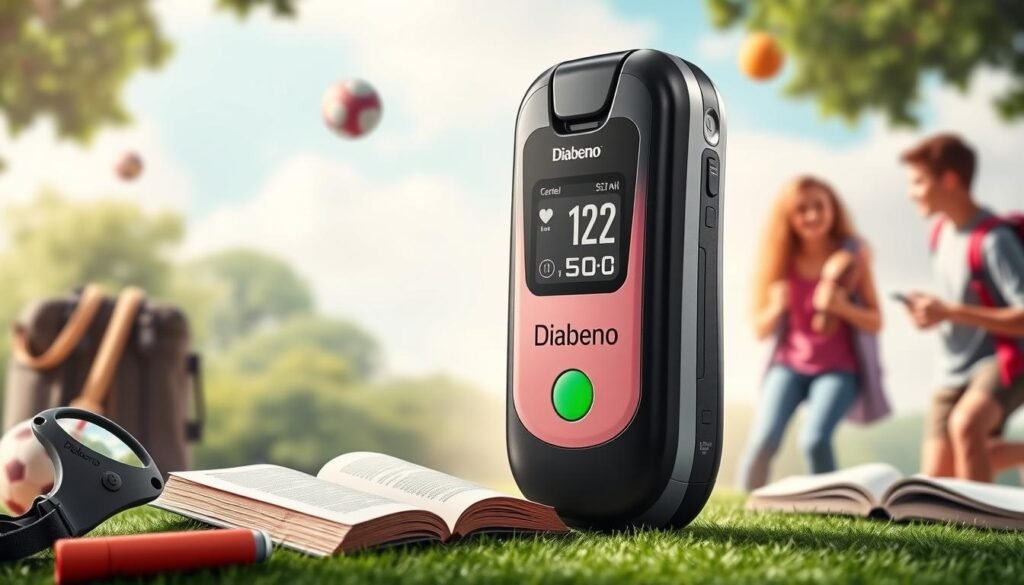
Cost and Insurance Coverage of Insulin Pumps
It’s key to know the cost of insulin pumps and what insurance covers. Insurance plans sort medications into tiers. This can change how much you pay for treatments20.
Lower tiers have generic meds, while higher tiers include brand-name and specialty meds20. The price can also depend on where you buy the supplies, like mail-order or retail pharmacies20.
For those needing help, discount programs from insulin makers can lower co-pays21. Also, insurance might limit how many test strips you can get in a time20.
Getting insurance coverage for insulin pumps can be tricky. You might need to show it’s medically necessary20. For example, some pumps, like the Omnipod®, might be covered differently20.
There are ways to get financial help. Insulin makers offer co-pay cards, but they don’t work for Medicare or Medicaid users21. Under Medicare Part D, insulin costs are capped at $35 a month, and you don’t need to meet a deductible21.
Looking into financial support for diabetes supplies is important. Knowing your insurance options can help manage costs better. Many Medicaid users pay little or nothing for prescriptions, but sometimes a small fee applies21.
Teen-Friendly Diabetes Management Strategies
Effective teen diabetes management strategies are key for teens with type 1 diabetes (T1D). Using diabetes technology for teens helps you manage your health better. Digital apps can track blood sugar and remind you to take insulin, making it easier to manage your diabetes.
It’s important to stay active, but many teens with T1D find it hard to exercise enough. Most kids and teens with type 1 diabetes don’t get enough physical activity compared to their friends22. Joining friends in sports or activities can make exercise more fun and help you stay healthy.
Puberty, menstruation, and stress can affect your blood sugar levels. You might need more insulin during puberty because of growth. Hormonal changes in teenage girls can also affect insulin levels23. Stress can cause blood sugar spikes because of cortisol, so you might need to adjust your insulin and management23.
To stay safe, make a checklist for outings to ensure you have everything you need. This helps when you’re active or doing sports related activities. Regular check-ins about your blood sugar can help you feel in control and accountable, showing you can manage your diabetes well.
It’s okay if you don’t do everything perfectly with diabetes. Setting realistic goals is important. It lets you deal with challenges without feeling guilty23. Look into youth diabetes management techniques that fit your life to find support and build a network around you.

Insulin Pump Care Tips for Adolescents
Proper care of your insulin pump is key for managing diabetes well. Teens can greatly benefit from regular maintenance practices for insulin pumps. These steps help your pump work its best, leading to better health.
Regular Maintenance Practices
To keep your insulin pump in top shape, follow these tips:
- Check insulin levels often and replace supplies when needed.
- Change infusion sites every 2-3 days to avoid problems.
- Store your insulin pump in a cool, dry spot, away from heat.
- Clean the pump often with a mild detergent or a 70% alcohol wipe.
- Avoid exposing your pump to water during showers, swimming, or heat.
- Always have a backup plan ready in case of pump failure, as insulin pump safety is critical.
Staying Connected with Healthcare Providers
Keeping in touch with your healthcare provider is vital for managing diabetes. It’s smart to talk to your healthcare provider about any pump issues. This conversation helps tailor your treatment and ensures any changes are made on time. You can learn more about managing your diabetes at Medtronic Diabetes.
Conclusion
Insulin pump technology has changed how teens manage diabetes. These pumps offer flexibility and better blood sugar control. This leads to better health for teens.
Studies show a 0.6% drop in HbA1c levels in pump users over seven years24. This shows pumps are key in managing diabetes for young people. They allow for precise insulin doses and basal rates, fitting different lifestyles and diets.
Insulin pumps are more expensive than injections, but insurance can help25. They also reduce severe hypoglycemia and hospital stays for diabetic ketoacidosis24. This shows the importance of medical advice and family support for teens with diabetes.
Choosing the right insulin pump can give teens the tools for managing their diabetes. Education and proactive strategies help teens feel confident and resilient. This way, they can live fulfilling lives despite diabetes25.
FAQ
What are the best insulin pumps for teenagers?
How do insulin pumps work?
What are the advantages of using insulin pumps for teens?
What features should I look for in an insulin pump for my teen?
Are there specific insulin pump accessories that can benefit teenagers?
What support systems are available for teens using insulin pumps?
How can families manage the costs associated with insulin pumps?
What tips are there for maintaining an insulin pump?
Source Links
- https://pmc.ncbi.nlm.nih.gov/articles/PMC4458222/
- https://www.diabetes.co.uk/teenagers/teens-and-insulin-pumps.html
- https://www.omnipod.com/diabetes-hub/education/insulin-pump-therapy-for-children
- https://diabetes.org/about-diabetes/devices-technology/who-should-use-a-pump
- https://myhealth.alberta.ca/Health/pages/conditions.aspx?hwid=zx1815
- https://www.byramhealthcare.com/blogs/best-insulin-pumps-diabetes-management
- https://www.tandemdiabetes.com/why-tandem/pediatric
- https://www.omnipod.com/
- https://www.medtronic.com/ca-en/diabetes/home/what-is-diabetes/insulin-therapy/pumps-for-children.html
- https://pmc.ncbi.nlm.nih.gov/articles/PMC2936259/
- https://londondiabetes.com/news-and-events/pros-and-cons-of-insulin-pumps/
- https://myendoconsult.com/learn/best-insulin-pump/
- https://diabetes.thekids.org.au/contentassets/2a064fa16d9a4064b853951816aa1eb0/pump-comparison-table-2022.pdf
- https://diabetesonthenet.com/journal-diabetes-nursing/use-insulin-pumps-children-and-young-people-past-present-and-future/
- https://gluroo.com/blog/diabetes-101/all-about-insulin-pumps/
- https://childrenwithdiabetes.com/insulin-pump-therapy/
- https://www.makingdiabeteseasier.com/uk/managing-diabetes/insulin-pump-for-children
- https://link.springer.com/chapter/10.1007/978-1-4615-0507-5_12
- https://www.medtronicdiabetes.com/treatments/insulin-pump-therapy-for-kids
- https://www.breakthrought1d.org/t1d-resources/insurance/issues-around-insulin-pumps/
- https://www.breakthrought1d.org/t1d-resources/insurance/help-with-prescription-costs/
- https://pmc.ncbi.nlm.nih.gov/articles/PMC7364455/
- https://www.breakthrought1d.org/t1d-resources/relationships/supporting-teenagers-with-t1d/
- https://link.springer.com/article/10.1007/s00125-013-3007-9
- https://gluroo.com/blog/diabetes-101/pros-cons-insulin-pumps-children/
